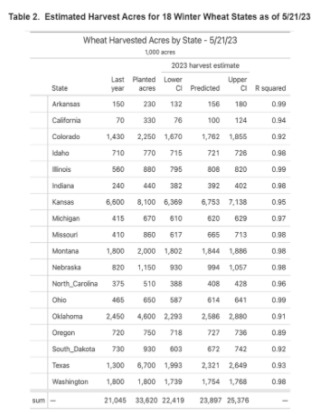And while the “goodness of fit,” (i.e., R2 = .1441) isn’t that high, there is clearly a relationship between good crop conditions and yield prospects.
At the time of this writing, July Hard Red Winter Wheat futures were trading in the lower $5.70s, which unfortunately aren’t that far from the contract lows near $5.50 per bushel. For many Kansas farmers, it has been challenging to forward price their wheat this year at profitable levels.
The chart below depicts the seasonality of average Kansas wheat prices as reported by USDA’s National Agricultural Statistics Service (NASS). Three seasonals — the five-, 10- and 15-year averages — are charted but each shows that as we near harvest, in May and June, prices improve, suggesting patience before we do any further preharvest marketing.

Developing a Postharvest Marketing Plan
When considering postharvest marketing, there are roughly five alternatives to consider:
1. Store unhedged (possibly what many folks consider)
2. Store and hedge, (store the crop and sell futures or buy a put option)
3. Sell the crop at harvest (what a lot folks do)
4. Sell the crop and buy a call option1 (“minimum price contract”)
5. Sell the crop; buy a call and sell a call (i.e., a call spread, in order to lower the overall cost).

As the chart above depicts, our analysis2 of storing wheat both on farm and commercially, unhedged, suggests that year-in and year-out, it is not profitable. My estimate of wheat storage costs from harvest to mid-February is roughly $0.31 per bushel for on farm stored and $0.59 cents for commercially stored wheat.
Currently though, wheat basis is weaker (more negative) than average, and there is significant “carry” in wheat futures, meaning more defered futures contracts are much greater than new crop futures. For example, on April 10, March 2026 HRW wheat futures closed at $6.28½, $0.55½ greater than the July 2025 futures contract that closed at $5.73). Together, these suggest that storing wheat could be profitable. Clearly, farmers should continue to monitor their local basis and deferred futures. But let’s remember we saw the same signals last year at this time of year, and by the time we got to harvest, the market was signaling farmers to sell.
If you do decide to store your wheat, consider a storage hedge, which is selling deferred futures, in order to take advantage of the expected narrowing of basis.
Selling the Crop at Harvest
When you sell your wheat at harvest, you avoid both the seasonal tendancy for cash wheat prices to weaken into September, and the storage costs associated with storing the physical commodity, which are more expensive with today’s elevated interest rates.
Selling the Crop and Buying a Call Option
Call options provide a “buy” position in the futures market, so if futures rally postharvest, the call option will gain in value, just as stored grain will increase in value on price rallies. This is an alternative to consider, but option premiums can often be relatively expensive, sometimes as much or more than the costs of physically storing the grain.
Selling the Crop and implementing a Call Option Spread
This postharvest alternative involves buying an at-the-money (ATM) call option (i.e., an option strike price nearest to the futures contract price) and selling an out-of-the-money (OTM) call option (i.e., an option strike price well above the current futures price). This allows us to sell the cash wheat at harvest, avoiding storage costs, yet providing the opportunity to take advantage of any significant price rallies at less cost than simply “buying a call option.” Note though, that a call option spread will also cap your potential gains if and when futures surpass the OTM Call strike price.
Last year, in our “Winning The Game” webinars, we suggested this postharvest strategy, and followed an example beginning on June 28, 2024, when March HRW wheat futures were at $6.16¾. The strategy involved buying a $6.20 ATM March HRW wheat call option for $0.49½, and selling a $6.70 OTM call for $0.33½, thus our net cost was $0.18 per bushel ($0.49½ - $0.33½ - $0.02 commission = $0.18). If prices rallied significantly, the call spread would provide a maximum gain of roughly $0.30 per bushel, and the $0.18 per bushel net cost represented the maximum loss we might incur if prices did not rally.
As you might recall, last fall wheat futures largely traded sideways to lower, but in January, March HRW wheat futures rallied and Feb. 14, a date very close to when the March options would expire, marked the first of three trading days where March wheat futures and options closed at levels high enough to earn a slight (¾ cent) positive return. Thus, while there were really no profits generated, from this alternative last year, it was a much better return than actually storing the 2024 crop.
Click here to see more...